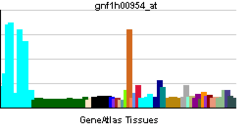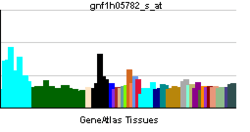SPPL2A
| View/Edit Human | View/Edit Mouse |
Signal peptide peptidase-like 2A, also known as SPPL2A, is a human gene.[4]
Function
This gene is a member of the signal peptide peptidase-like protease (SPPL) family and encodes an endosomal membrane protein with the conserved active site motifs 'YD' and 'GxGD' in adjacent transmembrane domains (TMDs). This protein plays a role in innate and adaptive immunity by cleaving TNFα in activated dendritic cells.[5][6] A pseudogene of this gene also lies on chromosome 15.[4]
References
- ↑ "Diseases that are genetically associated with SPPL2A view/edit references on wikidata".
- ↑ "Human PubMed Reference:".
- ↑ "Mouse PubMed Reference:".
- 1 2 "Entrez Gene: SPPL2A signal peptide peptidase-like 2A".
- ↑ Friedmann E, Hauben E, Maylandt K, et al. (2006). "SPPL2a and SPPL2b promote intramembrane proteolysis of TNFalpha in activated dendritic cells to trigger IL-12 production". Nat. Cell Biol. 8 (8): 843–8. doi:10.1038/ncb1440. PMID 16829952.
- ↑ Fluhrer R, Grammer G, Israel L, et al. (2006). "A gamma-secretase-like intramembrane cleavage of TNFalpha by the GxGD aspartyl protease SPPL2b". Nat. Cell Biol. 8 (8): 894–6. doi:10.1038/ncb1450. PMID 16829951.
Further reading
- Weihofen A, Binns K, Lemberg MK, et al. (2002). "Identification of signal peptide peptidase, a presenilin-type aspartic protease.". Science. 296 (5576): 2215–8. doi:10.1126/science.1070925. PMID 12077416.
- Grigorenko AP, Moliaka YK, Korovaitseva GI, Rogaev EI (2002). "Novel class of polytopic proteins with domains associated with putative protease activity.". Biochemistry Mosc. 67 (7): 826–35. doi:10.1023/A:1016365227942. PMID 12139484.
- Strausberg RL, Feingold EA, Grouse LH, et al. (2003). "Generation and initial analysis of more than 15,000 full-length human and mouse cDNA sequences". Proc. Natl. Acad. Sci. U.S.A. 99 (26): 16899–903. doi:10.1073/pnas.242603899. PMC 139241
 . PMID 12477932.
. PMID 12477932. - Granneman S, Gallagher JE, Vogelzangs J, et al. (2003). "The human Imp3 and Imp4 proteins form a ternary complex with hMpp10, which only interacts with the U3 snoRNA in 60–80S ribonucleoprotein complexes". Nucleic Acids Res. 31 (7): 1877–87. doi:10.1093/nar/gkg300. PMC 152815
 . PMID 12655004.
. PMID 12655004. - Ota T, Suzuki Y, Nishikawa T, et al. (2004). "Complete sequencing and characterization of 21,243 full-length human cDNAs". Nat. Genet. 36 (1): 40–5. doi:10.1038/ng1285. PMID 14702039.
- Friedmann E, Lemberg MK, Weihofen A, et al. (2005). "Consensus analysis of signal peptide peptidase and homologous human aspartic proteases reveals opposite topology of catalytic domains compared with presenilins". J. Biol. Chem. 279 (49): 50790–8. doi:10.1074/jbc.M407898200. PMID 15385547.
- Gerhard DS, Wagner L, Feingold EA, et al. (2004). "The Status, Quality, and Expansion of the NIH Full-Length cDNA Project: The Mammalian Gene Collection (MGC)". Genome Res. 14 (10B): 2121–7. doi:10.1101/gr.2596504. PMC 528928
 . PMID 15489334.
. PMID 15489334. - Rual JF, Venkatesan K, Hao T, et al. (2005). "Towards a proteome-scale map of the human protein-protein interaction network". Nature. 437 (7062): 1173–8. doi:10.1038/nature04209. PMID 16189514.
- Otsuki T, Ota T, Nishikawa T, et al. (2007). "Signal sequence and keyword trap in silico for selection of full-length human cDNAs encoding secretion or membrane proteins from oligo-capped cDNA libraries". DNA Res. 12 (2): 117–26. doi:10.1093/dnares/12.2.117. PMID 16303743.
- Kimura K, Wakamatsu A, Suzuki Y, et al. (2006). "Diversification of transcriptional modulation: Large-scale identification and characterization of putative alternative promoters of human genes". Genome Res. 16 (1): 55–65. doi:10.1101/gr.4039406. PMC 1356129
 . PMID 16344560.
. PMID 16344560. - Kirkin V, Cahuzac N, Guardiola-Serrano F, et al. (2007). "The Fas ligand intracellular domain is released by ADAM10 and SPPL2a cleavage in T-cells". Cell Death Differ. 14 (9): 1678–87. doi:10.1038/sj.cdd.4402175. PMID 17557115.
This article is issued from Wikipedia - version of the 6/3/2016. The text is available under the Creative Commons Attribution/Share Alike but additional terms may apply for the media files.

